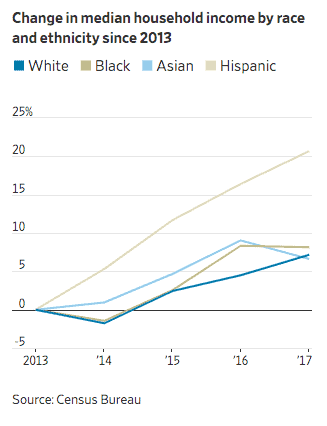The White Vote, the Hispanic Vote, and the Future of the GOP
Chris Roberts, American Renaissance, October 9, 2020

For decades, people have debated whether Hispanics can become loyal Republicans. The Left thinks not, and touts the growing Hispanicization of the US as the cornerstone of a permanent Democrat majority. Meanwhile, the GOP claims Hispanics are “natural conservatives” and that many will become Republicans.
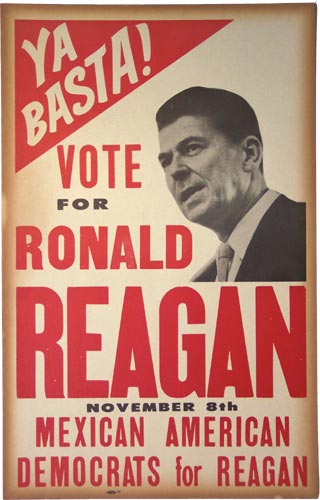
My research leads to three conclusions.
- There is a significant minority of Hispanics who vote Republican, and a smaller minority that does not have a strong allegiance to the Democrats.
- The percentages of Hispanics loyal to either party, along with the percentage of Hispanic “swing voters,” are unlikely to change soon.
- Barring a mass amnesty of illegal immigrants, it will be decades before a Hispanic “brown wall” makes it impossible for Republican candidates to win presidential elections.
Hispanic voting patterns
The Republican share of the Hispanic vote in presidential elections does not vary a great deal. Here are the numbers since 1980 according to a Pew Research Center analysis of exit-poll data:
| Year | GOP Share of Hispanic Vote |
| 1980 | 35 percent |
| 1984 | 37 percent |
| 1988 | 30 percent |
| 1992 | 25 percent |
| 1996 | 21 percent |
| 2000 | 35 percent |
| 2004 | 40 percent |
| 2008 | 31 percent |
| 2012 | 27 percent |
| 2016 | 28 percent |
The outliers have simple explanations. In 1992 and 1996, independent candidate Ross Perot won a significant number of votes, mostly from people who normally vote Republican. Perot won 14 percent of the Hispanic vote in 1992, and six percent in 1996. If you add his votes to the GOP totals for those two years, the numbers come back within the usual range.
George W. Bush’s share in 2004 was higher than usual. This is largely explained by two states, Texas and Florida, which were home to nearly one third of Hispanics. In Texas, where Mr. Bush had recently been a popular governor, he won 49 percent of the Hispanic vote. In Florida, where Cuban influence makes Hispanics more conservative than in the rest of the country — and where Mr. Bush’s brother was governor — he won 56 percent. Meanwhile, in California, Mr. Bush won a more typical Republican share: 32 percent. Aside from these three outliers (1992, 1996, 2004), in the last 40 years, GOP presidential candidates have always won between 27 and 37 percent of the Hispanic vote.

Oct. 25, 2012 – A Latina woman holds a sign in Spanish reading ‘We Are With You’ as Republican presidential candidate M. Romney speaks during a campaign stop in Columbus, Ohio.(Credit Image: © Michael Williams / ZUMAPRESS.com)
The Republican share is also loosely correlated with how well the Republican candidate did overall. Every time the GOP won 30 percent or more of the Hispanic vote — except in 2008 — it won the election. Every time the GOP won less than 30 percent of the Hispanic vote — except in 1988 and 2016 — it lost. President Ronald Reagan did very well with Hispanics in 1984, just as he did very well with everyone that year. George W. Bush won more of the Hispanic vote in 2004 than he did in 2000, just as he won more of the overall vote in 2004. There is no similar correlation with the Asian or black vote.
| Year | GOP Share of Hispanic Vote | Election Outcome |
| 2004 | 40 percent | GOP victory |
| 1984 | 37 percent | GOP victory |
| 1980 | 35 percent | GOP victory |
| 2000 | 35 percent | GOP victory |
| 2008 | 31 percent | Democrat victory |
| 1988 | 30 percent | GOP victory |
| 2016 | 28 percent | GOP victory |
| 2012 | 27 percent | Democrat victory |
| 1992 | 25 percent | Democrat victory |
| 1996 | 21 percent | Democrat victory |
It was not the Hispanic vote that gave the GOP victory; in many of these elections, the Hispanic electorate was too small to make much difference. What this correlation suggests instead is that Hispanics are unlike other minorities in that their support for a GOP candidate tends to increase when overall support increases. As Sam Francis put it in 2002, “The real reason Republican candidates in the late 1990s — Bob Dole and Jack Kemp in 1996, Dan Lungren in the California gubernatorial race in 1998 — lost more Hispanic votes than Republicans usually do is that they were weak candidates in general.”
The range of the GOP’s share of the Hispanic vote is similar to the range of support for Mexico’s only conservative party (PAN) in presidential elections. Here are results since 1994 (Mexico had elections before 1994, but they were rigged):
| Year | PAN (i.e. conservative) share of the national vote |
| 1994 | 27 percent |
| 2000 | 43 percent |
| 2006 | 36 percent |
| 2012 | 25 percent |
| 2018 | 22 percent |
This may be the general Mexican/Hispanic level of support for moderate, right-of-center parties.
Another factor is income. Hispanic fluctuations in median household income loosely correlate with the share of Hispanics that votes GOP: Both dropped in the 1990s, rose in the early 2000s, then dipped, and then began to rise.
Median income of Hispanic households in the United States from 1990 to 2019 (in 2019 U.S. dollars):
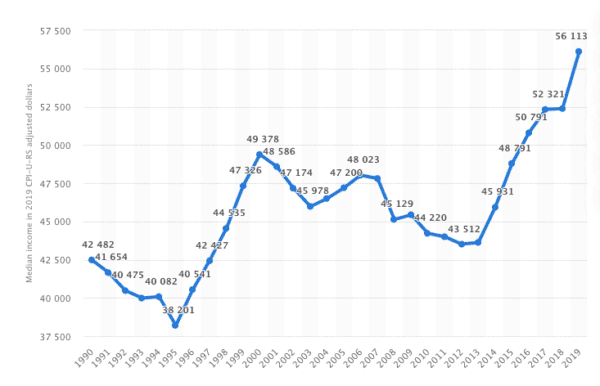
Source: Statista
The lowest Hispanic median household income in the 1990s was 1995: $38,201. The next year, the GOP got its lowest share of the Hispanic vote ever: 21 percent. The lowest Hispanic median household income in the 2010s was 2012: $43,512. That year, Mitt Romney won only 27 percent of the Hispanic vote, less than John McCain or Donald Trump.
The current president is not part of this trend. Hispanic income increased sharply in the last few years, but the GOP’s gains with Hispanics in 2016 were modest. However, Hispanic economic prosperity may help explain why President Trump’s Hispanic support has stayed level — and possibly risen — despite three and a half years of the mainstream media bellowing about “racism.” Polling shows Joe Biden doing worse than Hillary Clinton with Hispanics. One recent poll put Mr. Biden’s Hispanic support at 62 percent, Mr. Trump’s at 26 percent, with another 12 percent undecided.
In sum
The GOP can almost always expect 27 to 37 percent of the Hispanic vote, and this stability suggests that trying to appeal to Hispanics with pro-immigration policies is not very effective. In 1996, Bob Dole and Jack Kemp cast themselves and the GOP as believers in racial pluralism, multiculturalism, and mass immigration. That year, the GOP hit its record low for Hispanic support: 21 percent. Even if you add in Ross Perot’s Hispanic support, the total is still only 27 percent. In 2012, Mitt Romney earned the same share, despite pandering considerably less. The difference between what John McCain said about immigration, amnesty, and multiculturalism in 2008, and what what Donald Trump said in 2016 was enormous, but the difference in their Hispanic support was just 3 percent.
There is also a ceiling to Hispanic support. George W. Bush campaigned in Spanish, paraded his Hispanic family members, was a popular governor of a state with a large Hispanic population, and benefited from a strong economy and record-high levels of patriotism. He still only won 40 percent of Hispanics. If Mexico’s conservative party has never won more than 42.5 percent of the vote, why should Republicans do better?

June 23, 2012 – PAN candidate Josefina Vázquez Mota on the campaign trail in the Plaza de Toros in Mexico City. (Credit Image: © El Universal / ZUMAPRESS.com)
Could Hispanic support for the GOP plummet?
Asian support for the GOP went from a slight majority in the 1980s and 1990s to a small minority today. Could the same thing happen with Hispanics? There are three reasons this is unlikely: Class, education, and racial identity.
Class
In American politics, an annual income of $50,000 is a dividing line. People who make less generally vote Democrat; people who make more generally vote Republican. The best income range for Republicans is between $50,000 and $75,000. This group has voted majority GOP in every presidential election in modern history except in 1996, when Democrats narrowly won it because Ross Perot took so many Republican votes. Otherwise, the GOP wins these voters even when it loses richer voters.
Percent Republican/Democrat support (winner in red):
| Annual Income | 1992 | 1996 | 2000 | 2004 | 2008 |
| Under $15,000 | 23/58 | 29/59 | 37/57 | 36/63 | 25/73 |
| $15-29,999 | 35/45 | 37/53 | 41/54 | 42/57 | 37/60 |
| $30-49,999 | 38/41 | 40/48 | 48/49 | 49/50 | 43/55 |
| $50-74,999 | 41/40 | 45/47 | 51/46 | 56/43 | 49/48 |
| $75,000-99,999 | N/A | 48/44 | 52/45 | 55/45 | 48/51 |
| $100,000 and over | N/A | 54/28 | 54/43 | 58/41 | 49/49 |
| $200,000 and over | N/A | N/A | N/A | 63/35 | 46/52 |
The 2008 election is particularly instructive. Democrats won by a large margin that year, so much so that Republicans lost or tied all high income groups — but the middle-class $50k–$75k earners still went for the GOP. Data for 2012 and 2016 is less precise because pollsters began segmenting voters more broadly by income, but the pattern still holds.
Percent Republican/Democrat support (winner in red):
| Range | 2012 | 2016 |
| Under $30,000 | 35/63 | 41/53 |
| $30-$49,999 | 42/57 | 42/51 |
| $50-$99,999 | 53/45 | 50/46 |
| $100,000 and over | 54/44 | N/A |
| $100,000-$199,999 | N/A | 48/47 |
| $200,000-$249,999 | N/A | 49/48 |
| $250,000 and more | N/A | 48/46 |
This “Republican Middle Class” is the economic bracket many Hispanics are entering. Median Hispanic household income broke the $50k line for the first time four years ago. Moreover, Hispanics have done well for themselves over the last few years. The Wall Street Journal reported that, “Median income for Hispanic households rose 3.7% in 2017, easily outpacing the 1.8% growth for all households.” That year was not an anomaly. From 2013 to 2017, Hispanic median income grew 20.7 percent.
To repeat: income fluctuations seem to explain Hispanic voting patterns better than do positions a politician takes on immigration. George W. Bush and John McCain both promoted immigration policies Hispanics are supposed to like and were from states with large Hispanic populations. Yet, Hispanic support for Mr. McCain fell significantly from what Mr. Bush had enjoyed . . . just as the median Hispanic household income dropped, from $49,378 in 2000 to $45,129 in 2008.
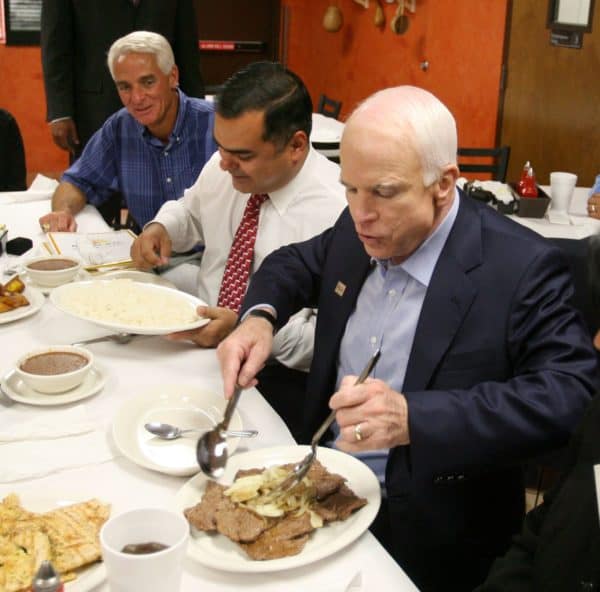
GOP presidential candidate Sen. John McCain tries a dish with Ramon Ojeda, president of the Hispanic Chamber of Commerce of Metro Orlando and Gov. Charlie Crist at Mi Viejo San Juan restaurant in east Orlando, Florida, October 23, 2008. (Credit Image: © Joe Burbank / MCT / ZUMAPRESS.com)
Hispanics are unlikely ever to surpass whites economically, or even become mostly middle class. Low IQ, high crime rates, and culture/language balkanization will keep some share of Hispanics in an underclass that will either not vote or vote Democrat. More capable Hispanics — those who are a part of the emerging Hispanic middle class — will be a reliable source of Republican support for decades, especially as the Democrat Party becomes a party of the very poor and the very rich.
Education
Another reason Hispanics aren’t set to go all-in for the Democrat Party is education. The most influential promoter of leftist ideas — particularly the most anti-white ones (“white privilege,” “institutional racism,” etc.) — is higher education. Four-year colleges are largely leftist indoctrination centers, but Hispanics — the least educated race in America — rarely attend them.
Educational Attainment of the Population Aged 25 and Older by Race and Hispanic Origin, as of 2015
| Race | High School Degree | Some College | Associates Degree | Bachelor’s Degree | Advanced Degree |
| Asian | 89.1 | 70.0 | 60.4 | 53.9 | 21.4 |
| White | 93.3 | 63.8 | 46.9 | 36.2 | 13.5 |
| Black | 87.0 | 52.9 | 32.4 | 22.5 | 8.2 |
| Hispanic | 66.7 | 36.8 | 22.7 | 15.5 | 4.7 |
Hispanics earn more money than blacks despite having less formal education, which suggests they take courses in practical, money-making fields in which leftist indoctrination is weakest. Those jobs put people in the middle class and make them more likely to vote Republican.
Identity
Although white advocates and liberals both think Hispanics should see themselves as a distinct “brown” group — or at least as “people of color” — Hispanics don’t always agree. When Hispanics are asked to choose a race — not including Hispanic, which the government does not consider a race — the majority choose “white.” Even Hispanics who say they are “multiracial” usually say “white” is one of their races. Many multiracial Hispanics also believe that others often see them as white:
 Many hard leftists think “whiteness” is wholly negative. Woke whites may exaggerate and even invent non-white ancestry to convince themselves and others they are not members of the oppressor race. If someone with obvious non-white ancestry considers himself entirely or partially white, he probably doesn’t know about or agree with the Left’s demonization of whites. Hispanic surrogates for the Democrat Party are all proud POCs and have a brown perspective — even when they are white or mostly white.
Many hard leftists think “whiteness” is wholly negative. Woke whites may exaggerate and even invent non-white ancestry to convince themselves and others they are not members of the oppressor race. If someone with obvious non-white ancestry considers himself entirely or partially white, he probably doesn’t know about or agree with the Left’s demonization of whites. Hispanic surrogates for the Democrat Party are all proud POCs and have a brown perspective — even when they are white or mostly white.

Jorge Ramos, a white Mexican who has made a career as an anti-white Hispanic.

Ruy Teixeira, a professional Hispanic who works as a demographer at the liberal Center for American Progress. (Credit Image: Center for American Progress)
People such as Mr. Teixeira and Mr. Ramos have convinced many liberal whites that all Hispanics are non-white leftists, but most Hispanics ignore this posturing. Few Hispanics attend universities that preach non- or anti-white identities and 39 percent of married, American-born, Hispanics have a non-Hispanic spouse — usually white, so the number of militant anti-whites will probably stay small.
Pandering: problems and prospects
In the long term, America’s demographic transformation will make it very hard for the GOP to win national elections, but it won’t happen as quickly as many people think. So long as Republican candidates — even anti-immigration ones — can win 27–37 percent of Hispanics, and higher levels in the important states of Texas and Florida, America’s Hispanicization will not doom them for decades.
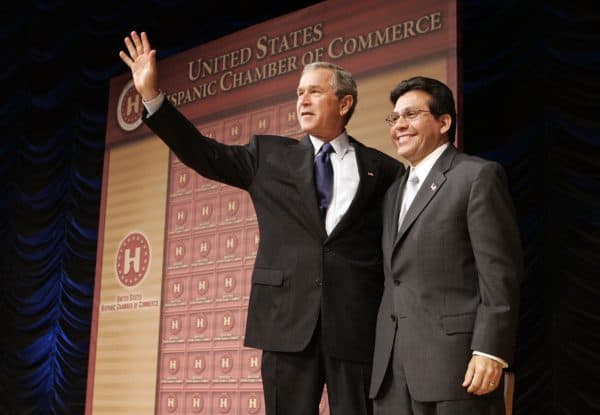
President George W. Bush waves next to Attorney General Alberto Gonzales after speaking to the Hispanic Chamber of Commerce, at the Ronald Reagan Building in Washington, D.C., April 20, 2005. (Credit Image: © Chuck Kennedy / TNS / ZUMAPRESS.com)
Even though the ceiling of Hispanic support for the GOP is low, some amount of “outreach” can still do some good. In 2016, Hispanic support in several key states was lower than it could have been: 22 percent in Pennsylvania and 26 percent in Ohio. Both states are often won by very small margins. Increasing Hispanic support, even to 31–34 percent, could help make them go “red.”
Perhaps the most important lesson from 2016 is this: The GOP can adopt national populist policies to win key white voters without losing a large number of Hispanics. Until 2016, analysts thought the GOP could win working-class whites only by losing Hispanics; or win upper- and middle-class Hispanics only by losing working- and lower-class whites. GOP strategists should recognize they can win more whites without losing many, if any, Hispanics.
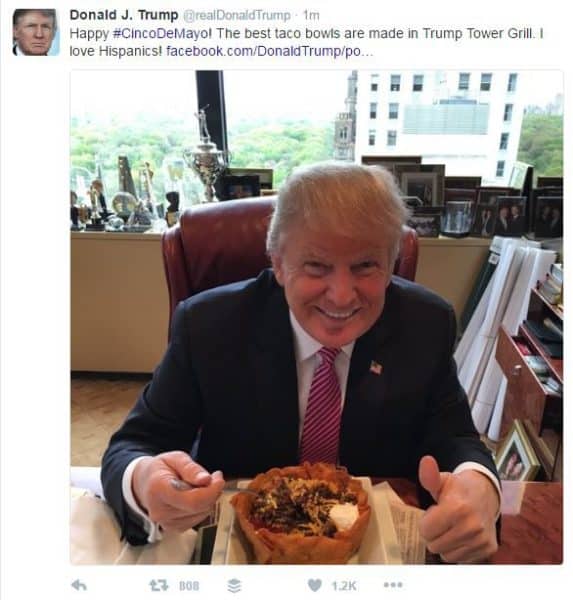
In 2020, President Trump’s biggest obstacle is not rising Hispanic opposition. He will win as many or slightly more Hispanic votes than he did in 2016. His problem is with certain white groups, namely old people, suburbanites, and women, who dislike his boorishness and the way he handled COVID. Meanwhile, Joe Biden showed during his fight for the Democrat nomination that he has much greater appeal with working-class whites than Hillary Clinton did.
But many of Mr. Trump’s weaknesses are unique to him. More able Republican candidates won’t have them. Talented conservative politicians could, in theory, continue to win national elections by only slightly increasing their share of the white vote (the “Sailer Strategy“) while holding onto a third of the Hispanic vote. The racial mix should not doom that strategy until 2050 or later. It all depends on whether the GOP can attract and keep white voters; Hispanics won’t make that much difference.
What could disrupt these patterns?
Economics
Over the last few years, Hispanics have grown richer more quickly than other races, and they vote GOP in larger numbers when they are doing well. However, COVID stopped that trend, and there is no way to know how long it will take Hispanics to recover. Even after COVID, no one can predict what the economy will do.
Venezuelans

November 9, 2018 – La Parada, Colombia – Refugees flee from Venezuela due to the crisis in their country, entering Colombia via the Simon Bolivar International Bridge across the Táchira River on the Venezuelan/Colombian border. (Credit Image: © Daniel Garzon Herazo / ZUMA Wire)
Since 2013, millions of Venezuelans — at least a tenth of the population — have fled a despotic and ruinous socialist regime. Until the virus complicated international travel, there were many predictions that Venezuelans would make up the new “refugee crisis.” So far, most have found new homes in South America and Spain, but a future American president could invite them in just as Angela Merkel did with Syrians. A Democrat might do this on humanitarian grounds, or a Republican as anti-Communist posturing. This would be a lot more likely if there were civil war in Venezuela and Latin American neighbors refused to let in any more refugees. An influx would be bad for the US, but might be good for the GOP. Venezuelans would almost certainly vote like Cubans — for Republicans. However, this will matter only if they land in states where they can make a difference. If they end up in California or New York, national politics wouldn’t change, even though they could tip swing states red.
Third parties
The GOP coalition has serious fissures, but the Democrats are even less united. Bernie Sanders showed that many Democrats want to move the party to the left. Sen. Sanders strongly endorsed his former primary rivals in 2016 and 2020, but the next socialist insurgent may not be so accommodating. The radical wing of the party is more visible and richer than before, and is eager for power. Progressives and socialists may leave and start a third party as Ross Perot did in the 1990s, or the left-wing populists in the 1880s–1920s.
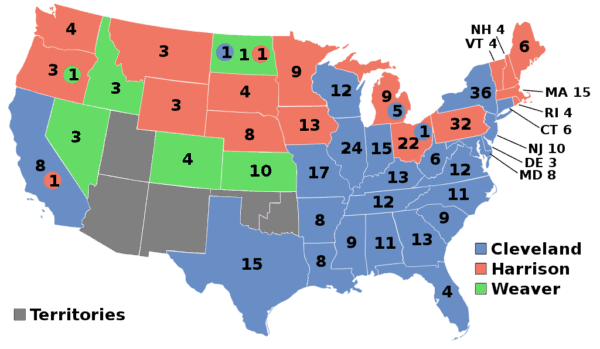
The results of the 1892 presidential election. States won by Democrat Grover Cleveland are in blue, by Republican Benjamin Harrison are in red, and won by Populist (aka “People’s Party”) James Weaver in green.
If this new party casts itself as a more radical version of the Democrats, it will take votes from them and help the GOP. But if it takes a more populist stance on economics and promotes unionization and a universal basic income rather than affirmative action and amnesty, it will draw working- and middle-class voters — white and Hispanic — from the Republicans.
Amnesty

May 21, 2007 – Phoenix, AZ (Credit Image: © Jack Kurtz / ZUMA Press)
There are at least 11 million illegal immigrants in the United States, the vast majority of whom are Hispanic. The GOP, with its 27–37 percent share of the Hispanic vote, can survive slight increases in the Hispanic share of the electorate — especially if it offsets them with gains among whites. But the sudden addition of several million voters who back Democrats 2-1 might be a death blow. As the population of illegal immigrants grows and becomes more Asian (Asians vote Democrat at higher rates than Hispanics), an amnesty a decade from now would be even more damaging than one next year.
The Hispanicization of the United States is bad news for the Republican Party. However, Republican death-by-demography is almost always heralded as coming very soon. Barack Obama’s back-to-back victories in 2008 and 2012 led many to believe that it had already come to pass. It hadn’t. America’s white majority still has another generation. Until then, the challenge for the GOP is not how many Hispanics it can win — that number won’t move much. The challenge is attracting more whites. White advocates, working inside or outside the GOP, face the same challenge.

